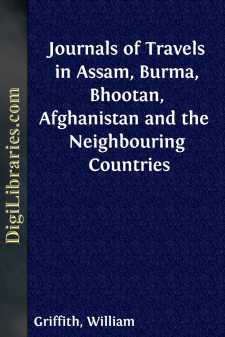Categories
- Antiques & Collectibles 13
- Architecture 36
- Art 48
- Bibles 22
- Biography & Autobiography 813
- Body, Mind & Spirit 142
- Business & Economics 28
- Children's Books 15
- Children's Fiction 12
- Computers 4
- Cooking 94
- Crafts & Hobbies 4
- Drama 346
- Education 46
- Family & Relationships 57
- Fiction 11828
- Games 19
- Gardening 17
- Health & Fitness 34
- History 1377
- House & Home 1
- Humor 147
- Juvenile Fiction 1873
- Juvenile Nonfiction 202
- Language Arts & Disciplines 88
- Law 16
- Literary Collections 686
- Literary Criticism 179
- Mathematics 13
- Medical 41
- Music 40
- Nature 179
- Non-Classifiable 1768
- Performing Arts 7
- Periodicals 1453
- Philosophy 64
- Photography 2
- Poetry 896
- Political Science 203
- Psychology 42
- Reference 154
- Religion 513
- Science 126
- Self-Help 84
- Social Science 81
- Sports & Recreation 34
- Study Aids 3
- Technology & Engineering 59
- Transportation 23
- Travel 463
- True Crime 29
Journals of Travels in Assam, Burma, Bhootan, Afghanistan and the Neighbouring Countries
by: William Griffith
Categories:
Description:
Excerpt
NOTICE OF WILLIAM GRIFFITH, from the Proceedings of the Linnæan Society, with a few extracts from his private correspondence.
“WILLIAM GRIFFITH, Esq., the youngest son of the late Thomas Griffith, was born on the 4th of March 1810, at his father’s residence at Ham Common, near Kingston-upon-Thames, in the county of Surrey.
“He was educated for the Medical profession, and completed his studies at the London University, where he became a pupil of Prof. Lindley, under whose able instructions, assisted by the zealous friendship of Mr. R. H. Solly, and in conjunction with two fellow pupils of great scientific promise, Mr. Slack and Mr. Valentine, he made rapid progress in the acquisition of botanical knowledge. The first public proofs that he gave of his abilities are contained in a microscopic delineation of the structure of the wood and an analysis of the flower of Phytocrene gigantea, in the third volume of Dr. Wallich’s ‘Plantæ Asiaticæ Rariores’; and in a note on the development and structure of Targionia hypophylla, appended to M. de Mirbel’s Dissertation on Marchantia polymorpha, both published in 1832. So highly were his talents as an observer appreciated at this early period, that Dr. Wallich speaks of him as one “whose extraordinary talents and knowledge as a botanist, entitle him to the respect of all lovers of the science;” and M. de Mirbel characterizes him as “jeune Anglois, très instruit, très zélé et fort bon observateur.”
“His note on Targionia is dated Paris, April 2nd, 1832, and in the month of May of the same year, having finished his studies at the London University with great distinction, he sailed from England for India, which was destined to be the scene of his future labours. He arrived at Madras on the 24th of September, and immediately received his appointment as Assistant-Surgeon in the service of the East India Company.
“His first appointment in India was to the coast of Tenasserim; but in the year 1835 he was attached to the Bengal Presidency, and was selected to form one of a deputation, consisting of Dr. Wallich and himself as botanists, and Mr. MacClelland as geologist, to visit and inspect the Tea-forests (as they were called) of Assam, and to make researches in the natural history of that almost unexplored district.
“This mission was for Mr. Griffith the commencement of a series of journeys in pursuit of botanical knowledge, embracing nearly the whole extent of the East India Company’s extra-peninsular possessions, and adding large collections, in every branch of natural history, but especially botany, to those which, under the auspices of the Indian Government, had previously been formed. He next, under the directions of Capt. Jenkins, the Commissioner, pushed his investigations to the utmost eastern limit of the Company’s territory, traversing the hitherto unexplored tracts in the neighbourhood of the Mishmee mountains which lie between Suddiya and Ava. Of the splendid collection of insects formed during this part of his tour some account has been given by Mr. Hope in the Transactions of the Entomological Society and in the eighteenth volume of our own Transactions....


